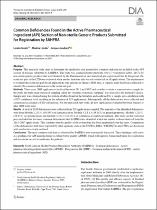| dc.contributor.author | Moeti, Lerato | |
| dc.contributor.author | Joubert, Jacques | |
| dc.date.accessioned | 2022-09-16T08:32:25Z | |
| dc.date.available | 2022-09-16T08:32:25Z | |
| dc.date.issued | 2023 | |
| dc.identifier.citation | Moeti, L., Litedu, M. and Joubert, J., 2021. Common Deficiencies Found in the Active Pharmaceutical Ingredient (API) Section of Non-sterile Generic Products Submitted for Registration by SAHPRA. Therapeutic Innovation & Regulatory Science, 56(2), pp.276-290. | en_US |
| dc.identifier.issn | 21684790 | |
| dc.identifier.uri | http://hdl.handle.net/10566/7897 | |
| dc.description.abstract | Purpose: This research study aims to determine the qualitative and quantitative common deficiencies included in the API section of dossiers submitted to SAHPRA. The study was conducted retrospectively over a 7-year period (2011–2017) for non-sterile generic products that were finalised by the Pharmaceutical and Analytical pre-registration Unit. In this period, the restricted part of the CTD was evaluated when needed therefore this was not conducted on all applications. The requirement to evaluate the restricted part for all applications was initiated in January 2020, thus, a separate study has been conducted to identify the common deficiencies in the restricted part. Methods: There were 2089 applications finalised between 2011 and 2017 and in order to attain a representative sample for the study, the multi-stage statistical sampling called the ‘stratified systematic sampling’ was selected as the method of choice. Sample size was obtained using the statistical tables found in the literature and confirmed by a sample size calculation with a 95% confidence level, resulting in the selection of 325 applications. Subsequently, all the deficiencies were collected and categorised according to CTD subsections. For the restricted part study, all new applications evaluated between January to May 2020 were used. Results: A total of 1130 deficiencies were collected from 325 applications sampled. The majority of the identified deficiencies were from Module 3.2.S.3.1 (19.38%) on characterisation, Module 3.2.S.1.3 (19.11%) on general properties, Module 3.2.S.4.1 (10.44%) on specifications and Module 3.2.S.4.3 (8.32%) on validation of analytical methods. The study on the restricted parts included the five most common deficiencies that SAHPRA has identified, which are similar to those observed from the 2011–2017 applications. This confirms that the quality of the evaluations has been maintained over the years. Comparison of the deficiencies with those reported by other agencies such as the USFDA, EMA, WHOPQTm and TFDA are discussed with similarities clearly outlined. Conclusions: The most common deficiencies observed by SAHPRA were extensively discussed. These findings could serve as a guidance for API manufacturers to submit better quality APIMFs which will improve turnaround times for registration and accelerate access to medicines for patients. © 2021, The Drug Information Association, Inc. | en_US |
| dc.language.iso | en | en_US |
| dc.publisher | Springer Science and Business Media Deutschland GmbH | en_US |
| dc.subject | Humans | en_US |
| dc.subject | pharmaceutical preparations | en_US |
| dc.subject | pharmacy | en_US |
| dc.subject | research design | en_US |
| dc.subject | retrospective studies | en_US |
| dc.subject | United States | en_US |
| dc.subject | United States food and drug administration | en_US |
| dc.title | Common Deficiencies Found in the Active Pharmaceutical Ingredient (API) Section of Non-sterile Generic Products Submitted for Registration by SAHPRA | en_US |
| dc.type | Article | en_US |

